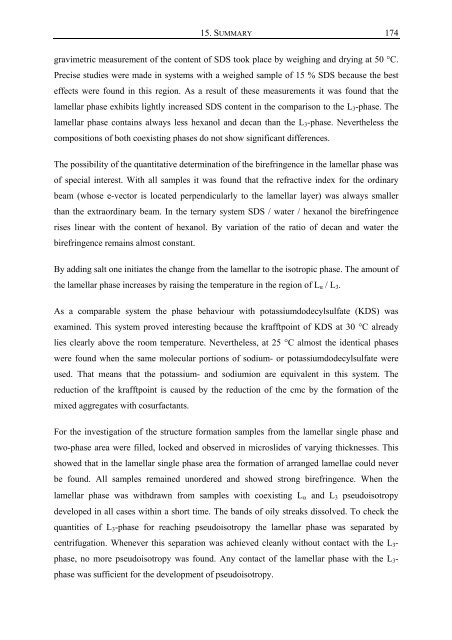Dokument_1.pdf (24284 KB) - OPUS Bayreuth - Universität Bayreuth
Dokument_1.pdf (24284 KB) - OPUS Bayreuth - Universität Bayreuth
Dokument_1.pdf (24284 KB) - OPUS Bayreuth - Universität Bayreuth
Sie wollen auch ein ePaper? Erhöhen Sie die Reichweite Ihrer Titel.
YUMPU macht aus Druck-PDFs automatisch weboptimierte ePaper, die Google liebt.
15. SUMMARY 174<br />
gravimetric measurement of the content of SDS took place by weighing and drying at 50 °C.<br />
Precise studies were made in systems with a weighed sample of 15 % SDS because the best<br />
effects were found in this region. As a result of these measurements it was found that the<br />
lamellar phase exhibits lightly increased SDS content in the comparison to the L 3 -phase. The<br />
lamellar phase contains always less hexanol and decan than the L 3 -phase. Nevertheless the<br />
compositions of both coexisting phases do not show significant differences.<br />
The possibility of the quantitative determination of the birefringence in the lamellar phase was<br />
of special interest. With all samples it was found that the refractive index for the ordinary<br />
beam (whose e-vector is located perpendicularly to the lamellar layer) was always smaller<br />
than the extraordinary beam. In the ternary system SDS / water / hexanol the birefringence<br />
rises linear with the content of hexanol. By variation of the ratio of decan and water the<br />
birefringence remains almost constant.<br />
By adding salt one initiates the change from the lamellar to the isotropic phase. The amount of<br />
the lamellar phase increases by raising the temperature in the region of L α / L 3 .<br />
As a comparable system the phase behaviour with potassiumdodecylsulfate (KDS) was<br />
examined. This system proved interesting because the krafftpoint of KDS at 30 °C already<br />
lies clearly above the room temperature. Nevertheless, at 25 °C almost the identical phases<br />
were found when the same molecular portions of sodium- or potassiumdodecylsulfate were<br />
used. That means that the potassium- and sodiumion are equivalent in this system. The<br />
reduction of the krafftpoint is caused by the reduction of the cmc by the formation of the<br />
mixed aggregates with cosurfactants.<br />
For the investigation of the structure formation samples from the lamellar single phase and<br />
two-phase area were filled, locked and observed in microslides of varying thicknesses. This<br />
showed that in the lamellar single phase area the formation of arranged lamellae could never<br />
be found. All samples remained unordered and showed strong birefringence. When the<br />
lamellar phase was withdrawn from samples with coexisting L α and L 3 pseudoisotropy<br />
developed in all cases within a short time. The bands of oily streaks dissolved. To check the<br />
quantities of L 3 -phase for reaching pseudoisotropy the lamellar phase was separated by<br />
centrifugation. Whenever this separation was achieved cleanly without contact with the L 3 -<br />
phase, no more pseudoisotropy was found. Any contact of the lamellar phase with the L 3 -<br />
phase was sufficient for the development of pseudoisotropy.
















